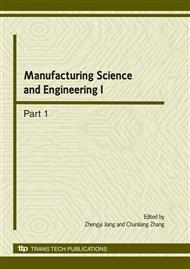p.149
p.153
p.158
p.162
p.166
p.170
p.176
p.182
p.187
Study on Deformation Mechanism of Tube Hydropiercing
Abstract:
The numerical simulation of tube hydropiercing process on a typical tubular component was conducted by employing the FEM code MARC in order to investigate the deformation mechanism of tube hydropiercing. The 3D FEM models have been established in both inward and outward punching operations. Based on the calculation results of the distributions and their changes of stress and deformation, a plastic bending deformation zone in the vicinity of the hole’s edge has been discovered, which differs greatly from that in the conventional sheet metal punching process. Influence of inner pressure on the quality of hydropierced hole was also investigated.
Info:
Periodical:
Pages:
166-169
Citation:
Online since:
March 2010
Authors:
Keywords:
Price:
Сopyright:
© 2010 Trans Tech Publications Ltd. All Rights Reserved
Share:
Citation:


